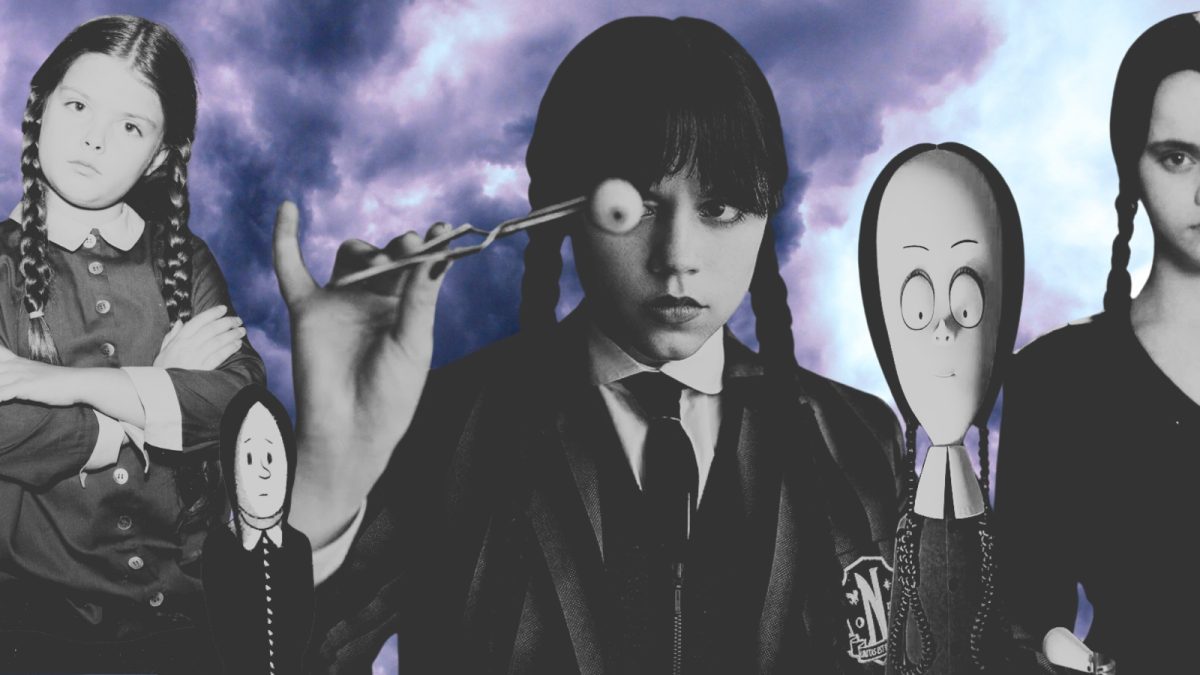When my 13-year-old daughter announced she was going to be Wednesday Addams for Halloween this year, my first question was, “Which Wednesday?” After Charles (Chas) Addams first drew Wednesday in a 1940 New Yorker cartoon, the pale, morose, dark-braided girl with a razor-sharp wit has appeared in various forms of media over the last 80 years. Each new Wednesday adds a twist to the character.
I returned to the source, the beginning of it all, when perusing Addams’s cartoons in the Internet library collection and The Addams Family: An Evilution (Pomegranate, 2010). Although there is disagreement about which Wednesday is truly the first, this handsome coffee table book published by Tee and Charles Addams Foundation identifies a 1940 jump-rope comic as the first appearance of Wednesday. In the single frame, a distressed dark-haired girl jumps rope on a shadowy city street. The caption reads, “Twenty-three thousand and one, twenty-three thousand and two, twenty-three thousand and three…”
The first Wednesday doesn’t wear the hallmark braids, but her wide forehead, oval-shaped eyes and white-collared black dress make her recognizable. The message of the comic itself is unclear. Is the girl possessed by a jump-rope demon? Is she challenging herself to some strange dare? And where are her parents? This comic differs from almost every other one because she is alone. In all the subsequent drawings, Wednesday joins the extended Addams crew.
However, this first comic introduces what we’ll experience of Wednesday for the next 80 years—an intriguing dissonance of cuteness and morbidity. Little girls are supposed to be made of sugar and spice, but this character brings us scorpions, guillotines, arsenic and electrocution chambers—a breath of fresh air for girls and women worldwide.
I don’t need to ask my daughter why she chose Wednesday. She’s someone who listens, observes her world keenly, speaks few—but meaningful—words. When she was a little girl, strangers on the street would implore her to “Smile, you’re beautiful!” and even as a two-year-old, she’d raise an eyebrow and make a skeptical face. Both my daughters know that being female doesn’t obligate them to perform for others. As a toddler, my younger daughter wore pink, sequins and bows from head to toe, but carried a giant, red-eyed, fanged Halloween rat figurine that startled passersby.
Wednesday has morphed and shape-shifted throughout her eight decades in popular culture, but this is largely due to the fluctuations in age and developmental stages.
Addams Family cartoons graced The New Yorker for nearly three decades, and the artist also lent his hand to shaping the plots of the 1960s sitcom, but he wasn’t around to see Christina Ricci propel Wednesday to new levels of brilliance in 1991. He also missed the 2019 animated Addams Family that is startlingly faithful to the original cartoons. (Morticia’s black tentacles at the bottom of her dress derive from Addams’s version of her). In the animated movie, Wednesday’s hair is braided into two nooses—a recurring theme in the New Yorker cartoons. It’s a concept you can imagine Addams wishing he’d thought of himself.
Throughout the film, which is visually impressive, but insipid in the story, there are countless small touches that bring us back to the original. Wednesday’s longing to assimilate into a normal, suburban life—and a housing development called Assimilation—strikes a false note. Still, her dark habits, such as the hobby of electrocuting her brother, resonate. At twelve or thirteen in this version, she’s believable as a Wednesday who is questioning who she is, even if it means veering off course temporarily.
Most recently, Wednesday has resurfaced in the eponymous Netflix series directed by Tim Burton and starring Jenna Ortega—and this version is the one my daughter has embraced for Halloween. Wednesday focuses on the older Addams’s child’s journey from life at home to a boarding school for “outcasts” grappling with supernatural powers and mysteries. At 14 or 15, she is older than any of the previous movies.
In the New York Times article, “The Many Shades of Wednesday Addams,” Devin Fuller asserts that no character in the entire Addams family “…has been portrayed quite as differently as the daughter, Wednesday.” True, Wednesday has morphed and shape-shifted throughout her eight decades in popular culture, but this is largely due to the fluctuations in age and developmental stages.
I would also argue that, despite the differences in maturity and external appearance, all of the Wednesdays possess a stubborn consistency. It might be harder for me to locate this true Wednesday in her 1990s appearance in a Honey Nut Cheerios commercial or as a poster child for M&Ms, and I’m not sure about the Scooby Doo appearance either (except she did play yo-yo with a live spider, which was spot on). Almost every other depiction of this character in the media contains at least a kernel of the original Addams’s creation. No matter how the character is packaged to appeal to social norms of each generation, Wednesday’s acidic lovability lives on and on. Here are some more glimpses into this true Wednesday:

1960s sitcom, The Adams Family
Lisa Loring plays Wednesday as an adorable six year-old who makes only fleeting appearances and knows not to take center stage. She is a cute punchline to the sitcom, but also subversive and quietly disrupting the patriarchy. Her father, Gomez undermines his wife, Mortiica, saying, “Don’t worry your pretty little head,” about money when the family is in a crunch. Wednesday takes it upon herself to open a (sort of) lemonade stand with her brother to raise funds for the family. Quietly but fiercely, Wednesday is worrying her pretty head–and selling poisoned drinks on the lawn. When a customer says, “I’ve had better glue than this,” Wednesday responds, deadpan, “I could make you glue on the rocks.”
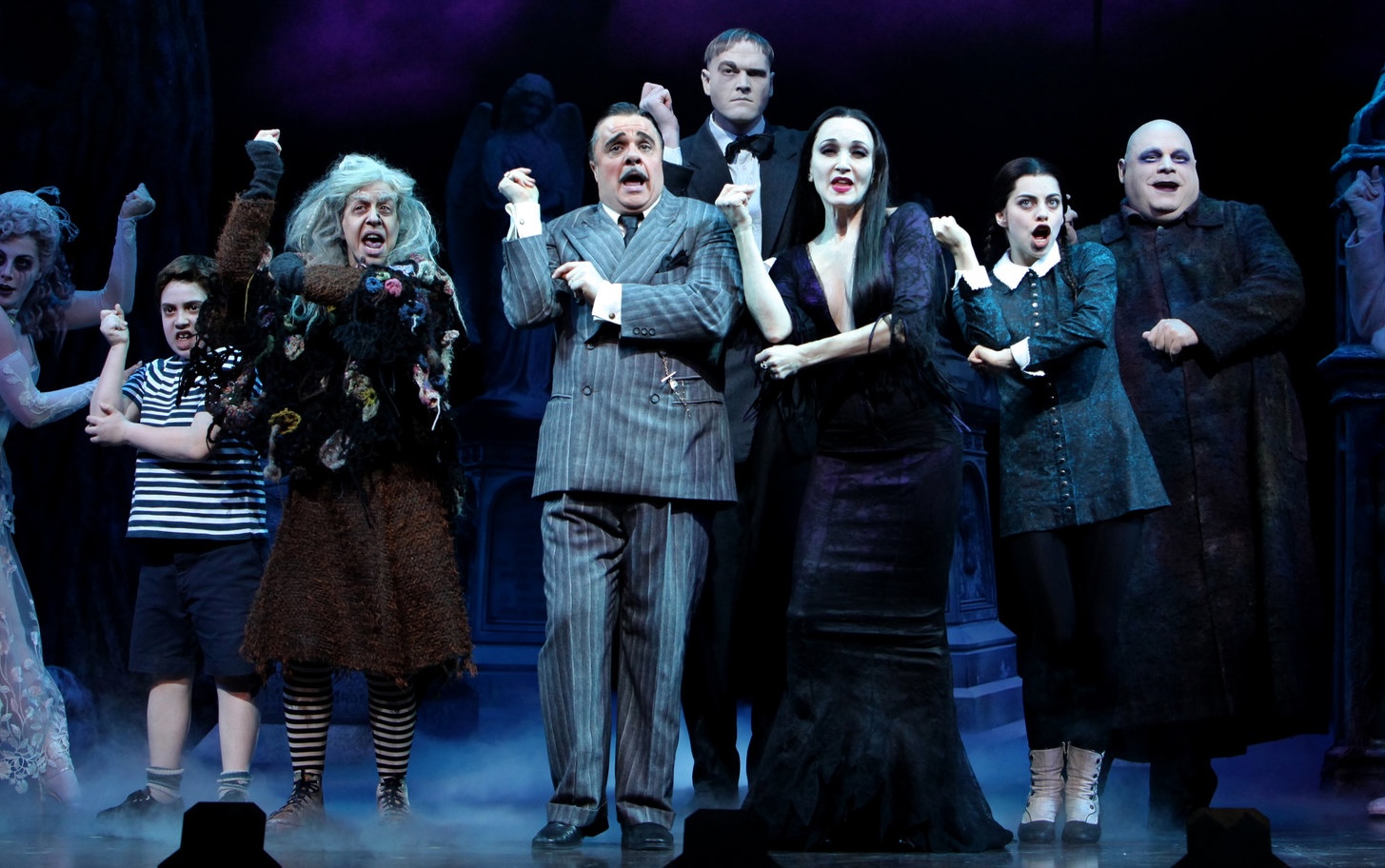
2010 Broadway musical, The Adams Family
Wednesday Adams is an older teenager of 18 or 19 who struts the stage in a black bob and black leather pants. Her biting humor slice through her lines, but her musical theater voice is louder and more mellifluous than we’re accustomed to. In all fairness, it would be hard to belt out Broadway tunes in a flat Wednesday voice. If it feels initially jarring to see Wednesday as a sexualized person, the “Crazier than You” number feels like an accurate depiction of how Wednesday would experience romance. When she dances around the stage with a crossbow, Wednesday’s would-be lover puts an apple on his head and invites her to use him for target practice. The Broadway version, although perhaps not my favorite depiction, still fits.
Wednesday: What if I miss?
Lover: Then you’ll be the last thing I ever see
Wednesday: That’s so hot.

1950s, New Yorker Cartoon
“The little dears! They still believe in Santa Claus.”
–Caption for a cartoon of Wednesday and brother Pugsley fanning the flames of the fireplace, and preparing for Santa to get scorched.
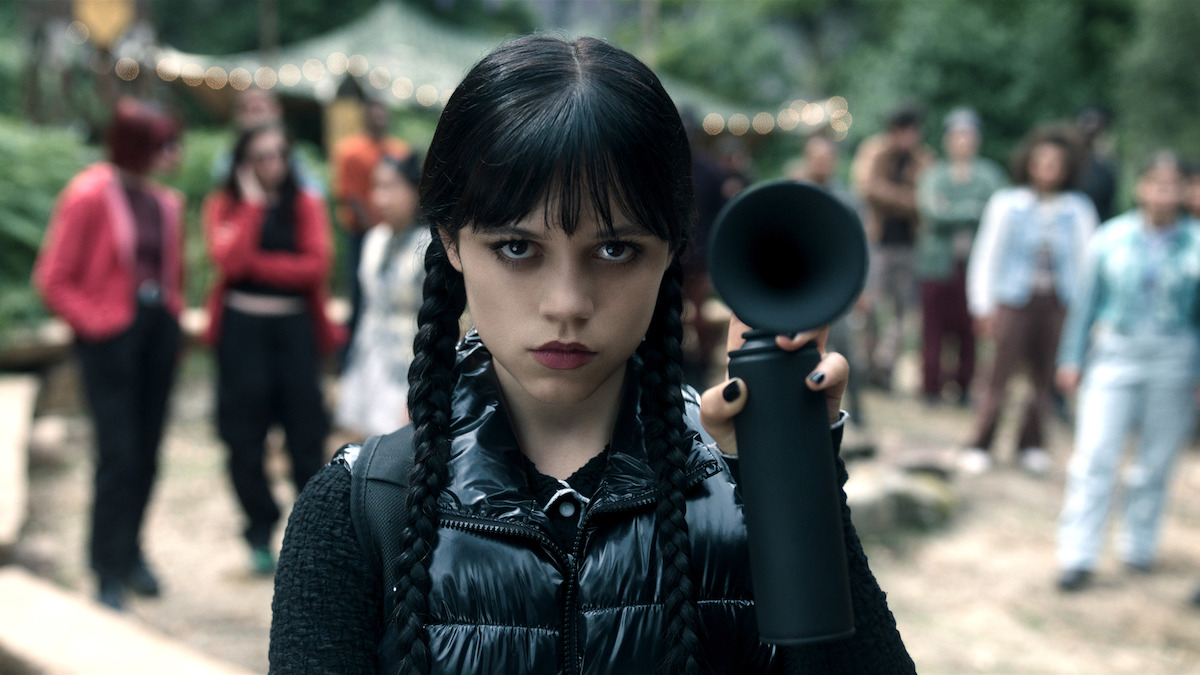
2022, Episode 1 and 2 of Netflix series Wednesday:
Wednesday:
“I know I’m stubborn, single-minded and obsessive. Those are all traits of great writers. Yes. And serial killers.”
“Editors are short-sighted, fear-based life forms.” Sigh. “I sent her a thank you” (a large mouse trap that snapped onto the editor’s hand!)
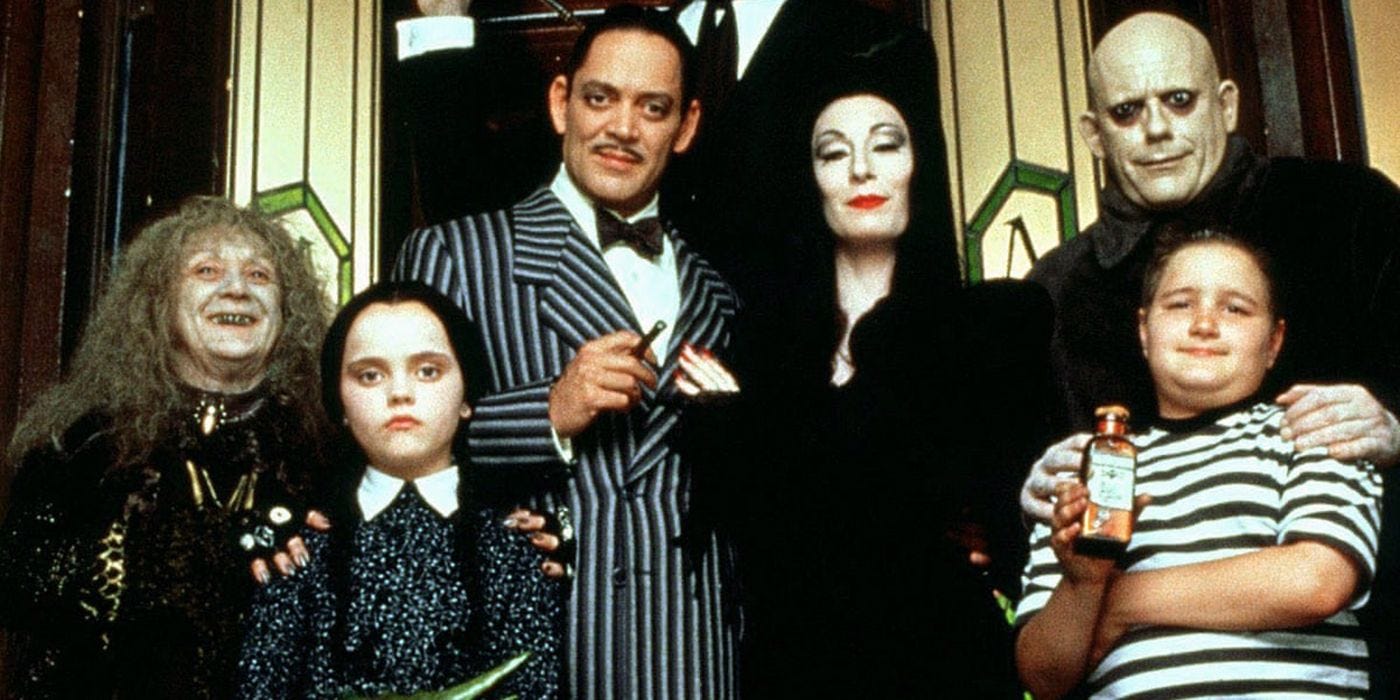
The Addams Family, 1991
Wednesday at the family dinner table: “May you pass the salt?”
Morticia: What do you say?
“Now!”
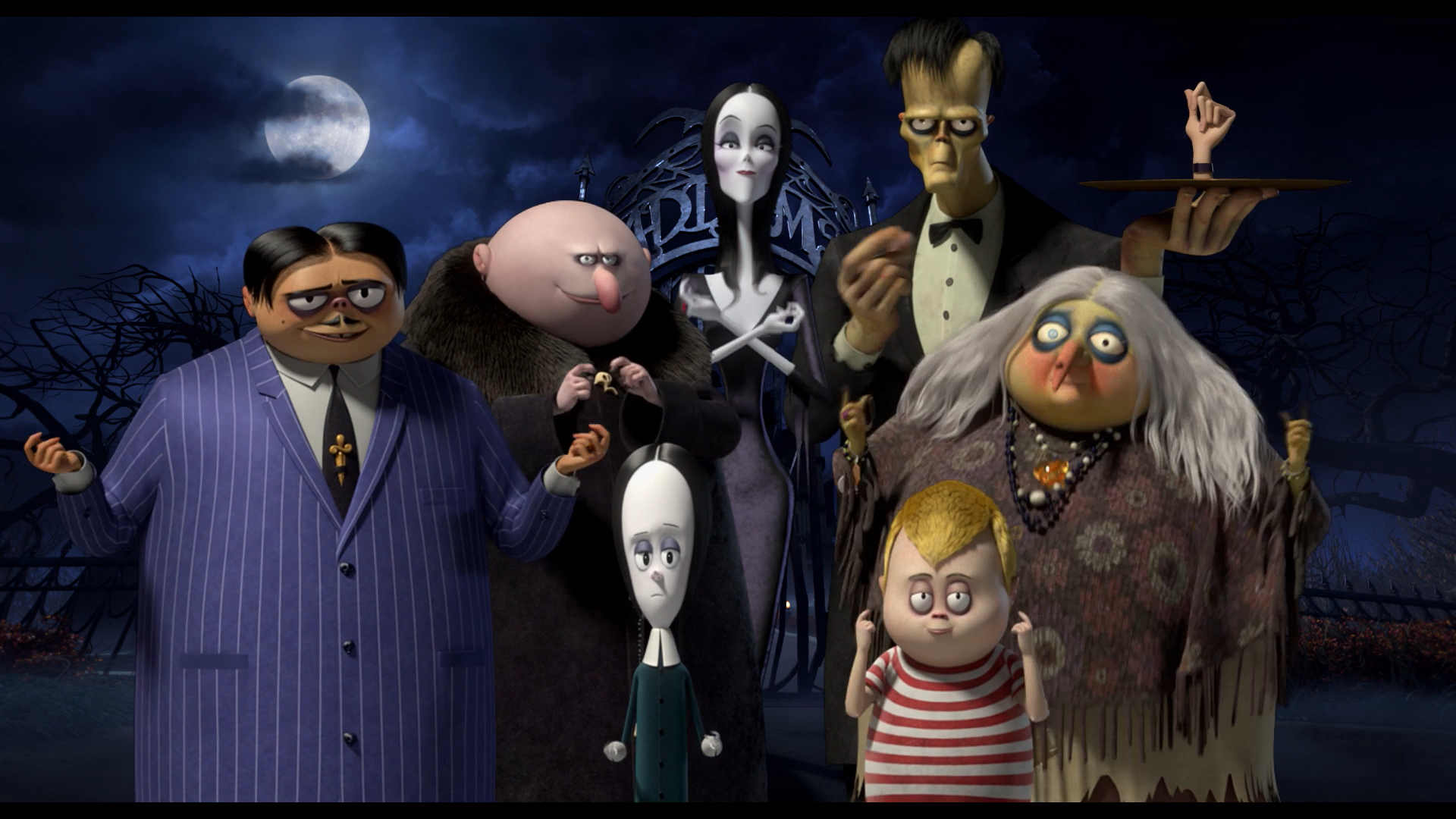
The Addams Family, animated, 2019
Wednesday: I’m “cage-schooled”
To her mother, Morticia: “Why would you deprive me of the opportunity to torment children my own age?”

Wednesday, 2020s Netflix series with Jenna Ortega
After she seeks revenge on her brother’s bullies by dropping piranhas into the pool, a school official says, “The boy’s father would have filed attempted murder charges, how would that look?”
“Terrible,” says Wednesday, “Then everyone knows I failed to get the job done.”

Christina Ricci, New Yorker Interview, January 17, 2022
Ricci: I was very much used to performing for people even before I was an actor. It was sort of the youngest-child thing I would do…I knew I had to be charming and happy when other people needed to be cheered up. With Wednesday, there was no emotion, no nothing, and for me that was great…”
Interviewer: “Did it feel natural to you to be that affectless?
Ricci: Yeah, it did. You know, there are moments in The Addams’ Family when you see Wednesday giggling and laughing. But she just was not a child that performs for adults.”
*
In Addams’s 125 Addams Family cartoons, Wednesday never grows older than five or six, a cute lap dog everyone toted around. And yet, she was distinctly her own person—alert, watchful and taking everything in, and cheerfully participates in one sinister situation after another. Whether pouring scalding liquid on Christmas carolers, opening up a cousin’s gift of a noose, or carrying dynamite on a family canoe paddling trip, Wednesday’s face and body speak volumes—but she doesn’t even earn one line of dialogue.
Ricci and then Ortega give voice to the character masterfully, each of them channeling and amplifying her voice. The child actress, Loring, had some zingers but her wit was swaddled in a sweetness that made her palatable for the 1960s. In Ricci’s 1991 role, she was snarky and sassy, but as a pre-sexual being tethered to her parents, she was still less complicated than the older Ortega.
Addams named Wednesday, “a child of woe,” after the nursery rhyme, “Monday’s Child,” at the suggestion of a friend, but I don’t see her as a mournful character in any iteration. Rather, she’s a person driven by her dark passions. About her, Addams wrote:
Child of woe: is wan and delicate with her mother’s dark hair and white complexion. Sensitive and on the quiet side, she loves the picnics and outings to the underground caverns often planned by Morticia and Gomez. She is a solemn child, prim in dress and, on the whole, pretty lost. Gomez is wild about her. Secretive and imaginative, poetic, seems underprivileged and given to occasional tantrums. Has six toes on one foot.
I may be a foolish optimist because I’m a mother of two daughters and a school librarian who works with hundreds of girls who I believe in, but I want to think that Ortega’s version of Addams’s character shows that life in America is getting better for women. We can solve mysteries, wrestle with dark, supernatural forces and maybe even find love without losing ourselves. I want to keep following all the Wednesdays—counting up her toes, laughing at her jokes—while searching for clues about who women are, and who we can be, in this world.
